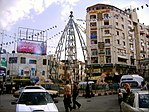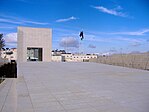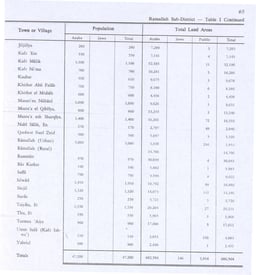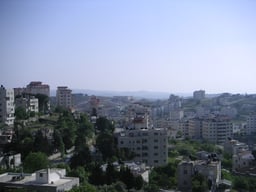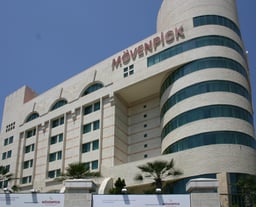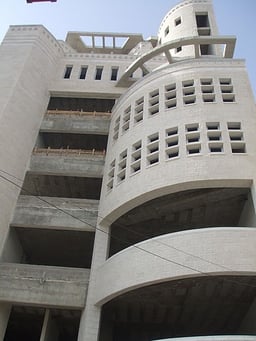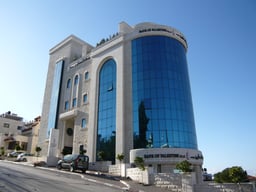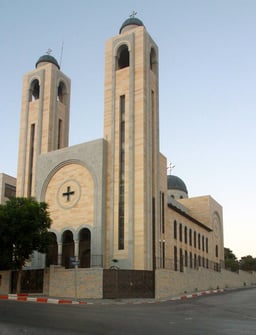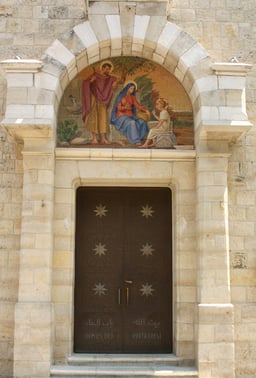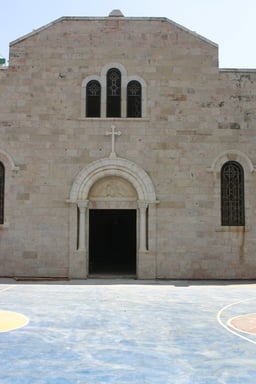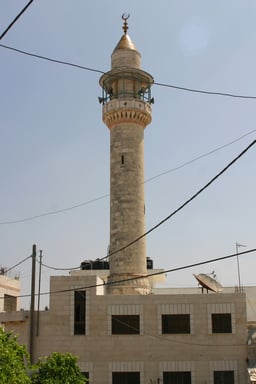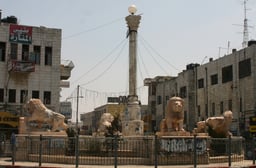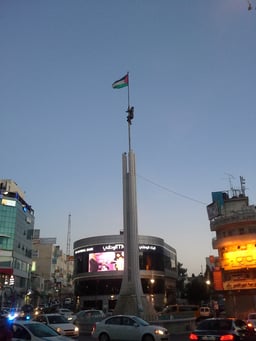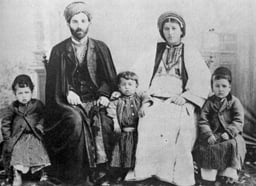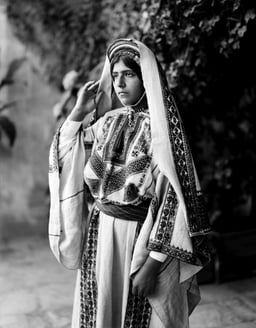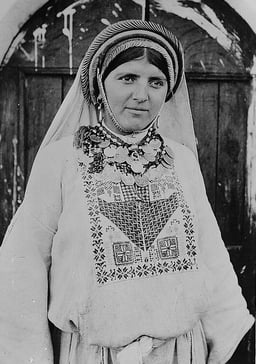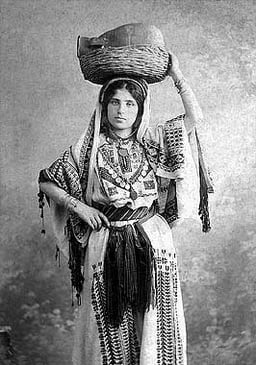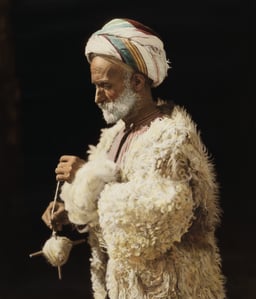Ramallah

Ramallah

Ramallah | |
|---|---|
Municipality type A (City) | |
| Arabic transcription(s) | |
| • Arabic | رام الله |
Clockwise from top: Ramallah skyline and the central mosque, Arafat mausoleum, Our Lady of the Annunciation Church, Roman ruins, Al-Manara Square | |
| Coordinates:31°54′N 35°12′E [119] | |
| Palestine grid | 168/145 |
| State | State of Palestine |
| Governorate | Ramallah and al-Bireh |
| Government | |
| • Type | City (from 1995) |
| • Head of Municipality | Musa Hadid |
| Area | |
| • Total | 16,344 dunams (16.3 km2 or 6.3 sq mi) |
| Population (2009)[2] | |
| • Total | 27,092[1] |
| Website | www.ramallah.ps [120] |
Ramallah (UK: /rəˈmælə/ rə-MAL-ə,[3] US: /rəˈmɑːlə/ rə-MAH-lə;[4] Arabic: رام الله, romanized: Rām Allāh, lit. 'God's Height'[5][6]) is a Palestinian city in the central West Bank located 10 km (6 miles) north of Jerusalem at an average elevation of 880 meters (2,890 ft) above sea level, adjacent to al-Bireh. It currently serves as the de facto administrative capital of the Palestinian National Authority (PNA). Ramallah was historically an Arab Christian town. Muslims form the majority of the population of nearly 27,092 in 2007,[2] with Christians making up a significant minority.
Ramallah | |
|---|---|
Municipality type A (City) | |
| Arabic transcription(s) | |
| • Arabic | رام الله |
Clockwise from top: Ramallah skyline and the central mosque, Arafat mausoleum, Our Lady of the Annunciation Church, Roman ruins, Al-Manara Square | |
| Coordinates:31°54′N 35°12′E [119] | |
| Palestine grid | 168/145 |
| State | State of Palestine |
| Governorate | Ramallah and al-Bireh |
| Government | |
| • Type | City (from 1995) |
| • Head of Municipality | Musa Hadid |
| Area | |
| • Total | 16,344 dunams (16.3 km2 or 6.3 sq mi) |
| Population (2009)[2] | |
| • Total | 27,092[1] |
| Website | www.ramallah.ps [120] |
History
Ramallah has been identified with the Crusader place called Ramalie.[9][10] Remains of a building with an arched doorway from the Crusader era, called al-Burj, have been identified,[[11]](https://openlibrary.org/api/books?bibkeys=ISBN:0521 46010 7&jscmd=data&format=json) but the original use of the building is undetermined.[12]
Ottoman era
Ramallah was incorporated into the Ottoman Empire in 1517 with all of Palestine. In 1596 it was listed in the tax registers as being in the nahiya of Quds, part of the Liwa of Quds. It had a population of 71 Christian households and 9 Muslim households. It paid a fixed tax rate of 25% on wheat, barley, olives, vines or fruit trees, and goats or beehives; a total of 9,400 akçe. All of the revenue went to a waqf.[13]
Modern Ramallah was founded in the mid-1500s by the Haddadins (also: Haddadeen), a clan of brothers descended from Ghassanid Christians. The Haddadins (ancestors of the present-day Jadallah family, among others), and their leader Rashid El-Haddadin, arrived from east of the Jordan River from the areas of Karak and Shoubak.[14] The Haddadin migration is attributed to fighting and unrest among clans in that area.
Rashid and his brothers were blacksmiths. The Haddadin name comes from the old (Aramaicܚܕܕ or ܚܕܐܕ ) word Haddad, which translates to blacksmith.
Haddadin was attracted to the mountainous site of Ramallah because it was similar to the other mountainous areas he came from. In addition, the heavily forested area could supply him with plenty of fuel for his forges.[14]
In 1838 American biblical scholar Edward Robinson visited the area, noting that the inhabitants were Christian "of the Greek rite". There were 200 taxable men, which gives an estimated total population of 800–900 people. The village "belonged" to the Haram al-Sharif, Jerusalem, to which it paid an annual tax of 350 Mids of grain.[15]
In 1883, the Palestine Exploration Fund's Survey of Western Palestine described Ramallah as
A large Christian village, of well-built stone houses, standing on a high ridge, with a view on the west extending to the sea. It stands amongst gardens and olive-yards, and has three springs to the south and one on the west; on the north there are three more, within a mile from the village. On the east there is a well. There are rock-cut tombs to the north-east with well-cut entrances, but completely blocked with rubbish. In the village is a Greek church, and on the east a Latin convent and a Protestant schoolhouse, all modern buildings. The village lands are Wakuf, or ecclesiastical property, belonging to the Haram of Jerusalem. About a quarter of the inhabitants are Roman Catholics, the rest Orthodox Greeks.[16]
In the 21st century, a large community of people with direct descent from the Haddadins who founded Ramallah live in the United States. The town is now predominately Muslim, but still contains a Christian minority. The change in demographics is due mostly to new migration of Muslims to the area, and emigration of Christians from the area.[14]
Christian presence
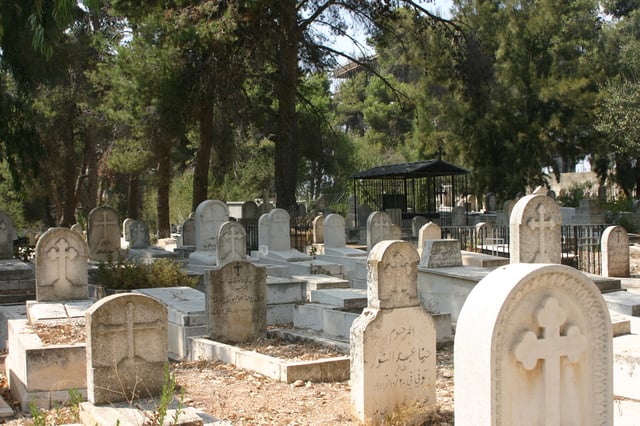
An old Christian cemetery in Ramallah.
Ramallah grew dramatically throughout the 17th and 18th centuries as an agricultural village; thus, attracting more (predominantly Christian) inhabitants from all around the region. In 1700, Yacoub Elias was the first Ramallah native to be ordained by the Eastern Greek Melkite Orthodox Church of Jerusalem, the Christian denomination that prevailed in the Holy Land at the time. In the early 19th century, the first Greek Melkite Jerusalemite Orthodox Christian church was built. Later in the 1850s, "The Church of Transfiguration", was built to replace it; it is the sole Orthodox Church in Ramallah today. During that same decade, the Latin (Roman Catholic) Church established its presence in Ramallah, constituting the second largest Christian denomination in the city. The Roman Catholic Church established the St. Joseph's Girls' School run by St. Joseph sisters, as well as the co-educational Al-Ahliyyah College high school runs by Rosary sisters. With the influx of Muslim and Christian refugees and internal migration, new mosques and churches were built.
In the 19th century, the Religious Society of Friends (Quakers) established a presence in Ramallah and built the Ramallah Friends Schools, one for girls and later a boys' school, to alleviate the dearth of education for women and girls. Eli and Sybil Jones opened "The Girls Training Home of Ramallah" in 1869. A medical clinic was established in 1883, with Dr. George Hassenauer serving as the first doctor in Ramallah. In 1889, the girls academy became the Friends Girls School (FGS). As the FGS was also a boarding school, it attracted a number of girls from surrounding communities, including Jerusalem, Lydda, Jaffa, and Beirut. The Friends Boys School (FBS) was founded in 1901 and opened in 1918. The Quakers opened a Friends Meeting House for worship in the city center in 1910.[17] According to the school's official website, most high school students choose to take the International Baccalaureate exams (IBE) instead of the traditional "Tawjihi" university exams.[18][19]
The activity of foreign churches in Palestine in the late 19th century increased awareness of prosperity in the West. In Ramallah and Bethlehem, a few miles south, local residents began to seek economic opportunity overseas. In 1901, merchants from Ramallah emigrated to the United States and established import-export businesses, selling handmade rugs and other exotic wares across the Atlantic. Increased trade dramatically improved living standards for Ramallah's inhabitants. American cars, mechanized farming equipment, radios, and later televisions became attainable luxuries for upper-class families. As residents of Jaffa and Lydda moved to Ramallah, the balance of Muslims and Christians began to change.
Ramallah was declared a modern city in 1908. It had an elected municipality as well as partnership projects with the adjacent town of al-Bireh. The Friends Boys School became a temporary hospital during World War I.
British Mandate
The British Army occupied Ramallah in December 1917 during the war years. Following the First World War, it was designated as a mandate territory and under British rule until 1948. The economy improved in the 1920s, and the landed aristocracy and merchants of the Palestinian upper class built stately multi-storied villas, many of which still stand.[20] The Jerusalem Electric Company brought electricity to Ramallah in 1936, and most homes were wired shortly thereafter. The same year the British inaugurated the "Palestine Broadcasting Service" in Ramallah. The British Broadcasting Corporation trained the local staff to deliver daily broadcasts in Arabic, Hebrew, and English. The station was later renamed "Kol Yerushalayim" (The Voice of Jerusalem).[21]
During the 1936–39 Arab revolt in Palestine, Ramallah was a center of activities against the British. Nancy Parker McDowell [22] describes vividly how the British attacked Ramallah using the Air Force. Many residents were killed and wounded. The wounded had to be transferred to Jerusalem since no significant medical facilities existed in Ramallah.
Jordanian era
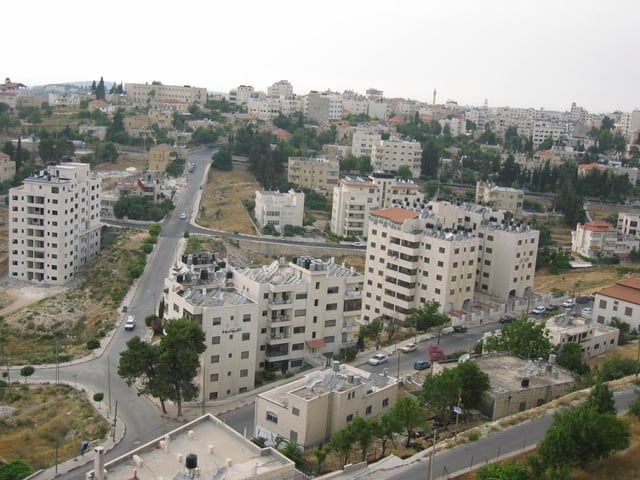
Residential neighborhood in Ramallah.
Following the creation of the State of Israel and the ensuing war, Jordan seized the part of Palestine they named the West Bank. This included Ramallah. The West Bank was relatively peaceful during the years of Jordanian rule between 1948 and 1967, with its residents enjoying freedom of movement between the West Bank, Jordan, Lebanon, and Syria. Jordan annexed the West Bank, applying its national law to the conquered territory. However, many Palestinians were jailed for being members of "illegal political parties", which included the Palestine Communist Party and other socialist and pro-independence groups. By 1953, Ramallah's population had doubled, but the economy and infrastructure could not accommodate the influx of poor villagers. Natives of Ramallah began to emigrate, primarily to the United States. By 1956, about one fourth of Ramallah's 6,000 natives had left, with Arabs from the surrounding towns and villages (particularly Hebron) buying the homes and land the émigrés left behind.
Israeli era
During the Six-Day War in 1967, Israel captured Ramallah from Jordan, imposing a military closure and conducting a census a few weeks later. Every person registered in the census was given an Israeli identity card which allowed the bearer to continue to reside there. Those who were abroad during the census lost their residency rights.[23] For residents of Ramallah, the situation had now been reversed. For the first time in 19 years, residents could freely visit Israel and the Gaza Strip and engage in commerce there.
Unlike the Jordanians, Israel did not offer citizenship to the residents. Ramallah residents were issued permits to work in Israel, but did not gain the rights associated with Israeli citizenship. The city remained under Israeli military rule for more than four decades.
The Israeli Civil Administration (CA), established in 1981, was in charge of civilian and day-to-day services such as issuing permission to travel, build, export or import, and host relatives from abroad.[24] The CA reprinted Jordanian textbooks for distribution in schools but did not update them. The CA was in charge of tax collection and land expropriation, which sometimes included Israeli theft of olive groves that Arab villagers had tended for generations.[25][26]
According to the Israeli Human Rights activists, the development of Jewish settlements in the Ramallah area, such as Beit El and Psagot, prevented the expansion of the city and cut it off from the surrounding Arab villages.[27] As resistance increased, Ramallah residents who were members of the Palestine Liberation Organization were jailed or deported to neighboring countries.[28] In December 1987, the popular uprising known as the Intifada erupted.
First Intifada
Ramallah residents were among the early joiners of the First Intifada. The Intifada Unified Leadership, an umbrella organization of various Palestinian factions, distributed weekly bulletins on the streets of Ramallah with a schedule of the daily protests, strikes and action against Israeli patrols in the city. At the demonstrations, tires were burned in the street, and the crowds threw stones and Molotov cocktails. The IDF responded with tear gas and rubber bullets. Schools in Ramallah were forcibly shut down, and opened gradually for a few hours a day. The Israelis conducted house arrests, imposing curfews that restricted travel and exports in what Palestinians regarded as collective punishment. In response to the closure of schools, residents organized home schooling sessions to help students make up missed material; this became one of the few symbols of civil disobedience.[29] The Intifada leadership organized "tree plantings" and resorted to the tactics used in pre-1948 Palestine, such as ordering general strikes in which no commercial businesses were allowed to open and no cars were allowed on the streets.
In 1991, the Palestinian delegation to the Madrid International Peace Conference included many notables from Ramallah. As the Intifada wound down and the peace process moved forward, normal life in Ramallah resumed. On September 13, 1993 Israeli Prime Minister Yitzhak Rabin and Palestinian Leader Yasser Arafat shook hands at a meeting at the White House. Schoolchildren in Ramallah handed out olive branches to Israeli soldiers patrolling the streets. In December 1995, in keeping with the Oslo Accords, the Israeli army abandoned the Mukataa and withdrew to the city outskirts. The newly established Palestinian Authority assumed civilian and security responsibility for the city, which was designated "Area A" under the accords.
Palestinian Authority rule
1990s
The years between 1993 and 2000 (known locally as the "Oslo Years") brought relative prosperity to Ramallah. Many expatriates returned to establish businesses there, and the atmosphere was one of optimism. In 2000, unemployment began to rise and the economy of Ramallah declined.[30][31] The Israel Defense Forces remained in control of the territories and its government did not restore the freedom of movement enjoyed by Ramallah residents prior to the first Intifada. Travel to Jerusalem required special permits. The number and size of Israeli settlements around Ramallah increased dramatically. A network of bypass roads for use of Israeli citizens only was built around Ramallah, and Israel confiscated land for settlements.[32][33]
Many official documents previously handled by the Israeli Civil Administration were now handled by the Palestinian Authority but still required Israeli approval. A Palestinian passport issued to Ramallah residents was not valid unless the serial number was registered with the Israeli authorities, who controlled border crossings.[34] The failure of the Camp David summit in July 2000 led to the outbreak of the Second Intifada (al-Aqsa Intifada) in September 2000.
Second Intifada
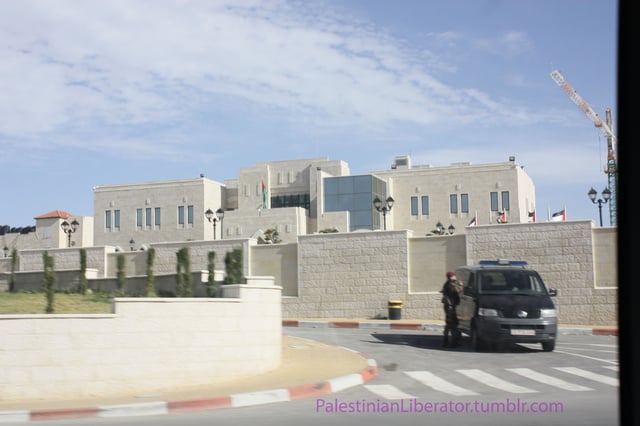
Mukataa in 2013.
Young Ramallah residents demonstrated daily against the Israeli army, with marches to the Israeli checkpoints at the outskirts of the city. Over time, the marches were replaced by sporadic use of live ammunition against Israeli soldiers; and various attacks targeting Jewish settlers, particularly on the Israeli-only bypass roads. Army checkpoints were established to restrict movement in and out of Ramallah.[35][36][37]
On October 12, 2000, two Israeli army reservists, Vadim Norzhich and Yosef Avrahami were lynched in Ramallah. They had taken a wrong turn, and were set upon by a mob, enraged in particular by the Muhammad al-Durrah incident in Gaza.[38] A frenzied crowd killed the two IDF reservists, mutilated their bodies, and dragged them through the streets.[39] Later that afternoon, the Israeli army carried out an air strike on Ramallah, demolishing the police station. Israel later succeeded in capturing and prosecuting some of those involved in the deaths of the reservists.
Although Ramallah and its immediate region, now known as Area A, came under collaborative or joint Israeli-Palestinian Authority (PA) administration in September 1995,[40] with civil administration vested fully in the PA, occasionally there have been breaches in security matters (beginning with 2002 in an IDF operation codenamed Operation Defensive Shield), and more recently in March 2017 while attempting to arrest a suspected terrorist, which saw Israeli military intervention in Ramallah.[41][42] In 2002, the army imposed curfews, electricity cuts, school closures and disruptions of commercial life.[43] Many Ramallah institutions, including government ministries, were vandalized, and equipment was destroyed or stolen.[44] The IDF took over local Ramallah television stations, and social and economic conditions deteriorated.[45] Many expatriates left, as did many other Palestinians who complained that the living conditions had become intolerable.[46][47][48] Construction of the Israeli West Bank barrier has added to Ramallah's isolation.
Yasser Arafat established his West Bank headquarters, the Mukataa, in Ramallah. Although considered an interim solution, Ramallah became the de facto capital of the Palestinian Authority, now officially known as the State of Palestine. It hosts almost all governmental headquarters. In December 2001, Arafat held meetings at the Mukataa, but lived with his wife and daughter in Gaza City. After suicide bombings in Haifa, Arafat was confined to the Ramallah compound. In 2002, the compound was partly demolished by the Israeli Defense Forces and Arafat's building was cut off from the rest of the compound.
On November 11, 2004 Arafat died at the Percy training hospital of the Armies near Paris. He was buried in the courtyard of the Mukataa on November 12, 2004. The site still serves as the Ramallah headquarters of the Palestinian Authority, as well the official West Bank office of Mahmoud Abbas. Throughout 2005, while the Disengagement Plan was underway, some US government officials suggested to the Palestinian leadership to move the provisional capital back to Gaza, where it had been when the Palestinian Aurhority was first established in 1994. President Abbas, however, refrained from doing so, arguing that at this point, it was important to keep the administrative center in the West Bank in order to remind the international community that the West Bank was still awaiting territorial solution.[49]
Economic rehabilitation
Munir Hamdan, a member of Fatah and a Ramallah businessman, discussed the concentration of government offices with a journalist. He said, "The president and prime minister have their offices here.[52] So do the parliament and all the government ministries", representing a "collusion" between the Palestinian Authority and Israel to turn Ramallah into the political as well as the financial capital of the Palestinians. He is particularly worried by the construction of a large new governmental complex by the PA.[52] Hatem Abdel Kader, a Jerusalem resident, Fatah legislator and former Minister for Jerusalem Affairs, complained that "If they are building a new government compound here, that means they have no plans to be based in Jerusalem... Unfortunately, the Palestinian government of Salam Fayyad has abandoned Jerusalem in favor of Ramallah."[52]
Many foreign nations have located their diplomatic missions to the Palestinian Authority in Ramallah, including, as of 2010, Argentina, Australia, Austria, Korea, South Africa, Norway, Sri Lanka, Switzerland, China, Poland, Portugal, The Netherlands, Russia, Jordan, Brazil, Finland, Denmark, Ireland, Germany, India, Japan, the Czech Republic, Canada and Mexico.[52]
In November 2011, king Abdullah II of Jordan visited Ramallah for the first time since 2000.[53]
Geography and climate
This area enjoys a Mediterranean climate of a dry summer and mild, rainy winter with occasional snowfall. The recorded average of Ramallah's rainfall is about 615 mm (24 in)[54] and minimum rainfall is 307 mm (12 in) and maximum rainfall is 1,591 mm (63 in).
The Köppen climate classification places Ramallah in the Csa category. Climates of this class generally occur on the western sides of continents between the latitudes of 30° and 45°. These climates are in the polar front region in winter, and thus have moderate temperatures and changeable, rainy weather. Summers are hot and dry, due to the domination of the subtropical high pressure systems, except in the immediate coastal areas, where summers are milder due to the nearby presence of cold ocean currents that may bring fog but prevent rain.
Economy
Ramallah has been described as the seat of power of the Palestinian Authority and serves as the headquarters for most international NGOs and embassies. Hundreds of millions of dollars in aid flowing into the city have boosted Ramallah's economy greatly since the end of the Second Intifada.[55]
The Ramallah construction boom is one of the most obvious signs of West Bank economic growth, estimated at an annual rate of 8 percent. This has been attributed to relative stability and Western donor support to the Palestinian Authority. Ramallah's buoyant economy continues to draw Palestinians from other West Bank towns where jobs are fewer. The built-up area has grown fivefold since 2002.[56]
By 2010, Ramallah had become the leading center of economic and political activity in the territories under the control of the Palestinian Authority.[52] During a building boom in the early years of the 21st century, apartment buildings and "five-star" hotels were erected, particularly in the Al-Masyoun neighborhood.[52] In 2010, "more than one hundred" Palestinian businesses were reported to have moved to Ramallah from East Jerusalem, because "Here they pay less taxes and have more customers."[52] One local boasted to a journalist that "Ramallah is becoming the de facto capital of Palestine."[52] This boast was seconded by The New York Times which, in 2010, called Ramallah the "de facto capital of the West Bank.[57] According to Sani Meo, the publisher of This Week in Palestine, "Capital or no capital, Ramallah has done well and Palestine is proud of its achievements."[52] Some Palestinians allege that Ramallah's prosperity is part of an Israeli "conspiracy" to make Ramallah the capital of a Palestinian state, instead of Jerusalem.[52]
ASAL technologies, an information technology company in Ramallah, has 120 employees and is looking forward to "exponential growth".[58]
Demographics
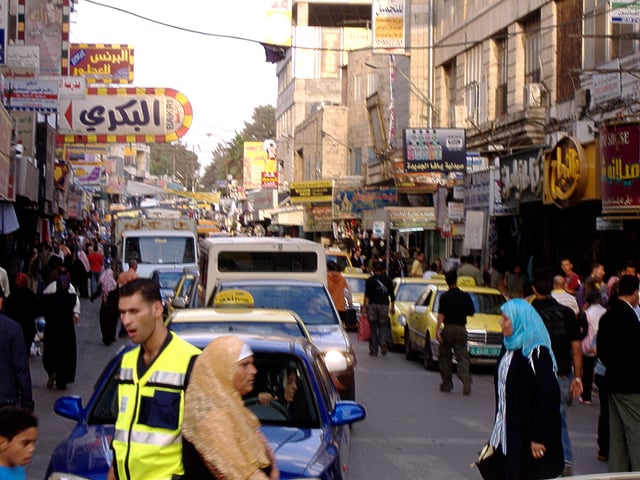
Main street in Ramallah
In the 1922 census of Palestine conducted by the British Mandate authorities, Ramallah had a population of 3,104; 2,972 Christians, 125 Muslims, and 10 Jews,[63][64] where the Christians were 2,162 Orthodox, 1 Syrian Orthodox (Jacobite), 332 Roman Catholics, 144 Greek Catholic (Melchite), 211 Church of England, and 122 "other".[65] The population increased at the time of the 1931 census to 4,286, with 3,766 Christians, 519 Muslims and 1 Jew, in a total of 1014 houses.[66]
In the 1945 statistics, the population stood at 5,080,[67] with Christians forming the majority of the population. However, the demographic makeup of the town changed drastically between 1948 and 1967, when considerable emigration of Christians took place. Slightly more than half of the city's 12,134 inhabitants were Christian by 1967, the other half Muslim.[68]
Ramallah's population drastically decreased in the late 20th century from 24,722 inhabitants in 1987 to 17,851 in 1997. In the Palestinian Central Bureau of Statistics (PCBS) census in 1997, Palestinian refugees accounted for 60.3% of the population, which was 17,851.[69] There were 8,622 males and 9,229 females. People younger than 20 years of age made up 45.9% of the population, while those aged between 20 and 64 were 45.4%, and residents aged over 64 constituted 4.7%.[70]
Only in 2005 did the population reach more than 24,000. In a PCBS projection in 2006, Ramallah had a population of 25,467 inhabitants.[71] In the 2007 PCBS census, there were 27,460 people living in the city.[72] Sources vary about the current Christian population in the city, ranging around 25%.[73][74]
Infrastructure
Health
In the aftermath of the 1936–39 Arab revolt, the Ramallah Hospital Foundation was established and registered as a tax exempt organization in New York in 1944. It bought large pieces of land in the south-eastern fringes of the city dedicated for the future hospital. In 1963 a hospital was opened.[75] The present Ramallah Government Hospital and the Palestine Medical Centered are located on the land purchased by the Foundation. In January 1987 the first open-heart surgery was performed at the Hospital under the direction of Dr. Shehadeh (Shawki) Harb, a Palestinian surgeon trained in the United States.
Religious institutions
The Jamal Abdel Nasser Mosque is one of the city's largest. The Orthodox Church of Ramallah, an Orthodox Christian convent, Melkite Catholic Church, Evangelical Lutheran Church, Arab Episcopal (Anglican) Church, Ramallah Local Church (Evangelical\Born Again) and Ramallah Baptist Church all operate schools in the city.[18] A large new church has been built on top of one of the highest hills of Ramallah, belonging to the Coptic Orthodox Church. A small group of Jehovah Witnesses are present in the area as well and others.
During the annual "Saturday of Light" religious festival (which occurs on the Saturday between Good Friday and Easter Sunday to commemorate the light that tradition holds shone from the tomb of Jesus), the scouts hold a parade through the city streets to receive the flame from Jerusalem. (The flame is ignited in Jerusalem's Church of the Holy Sepulchre and is passed on through candles and lanterns to regional churches.) A variety of mosques and churches of different denominations dot the landscape.
Culture
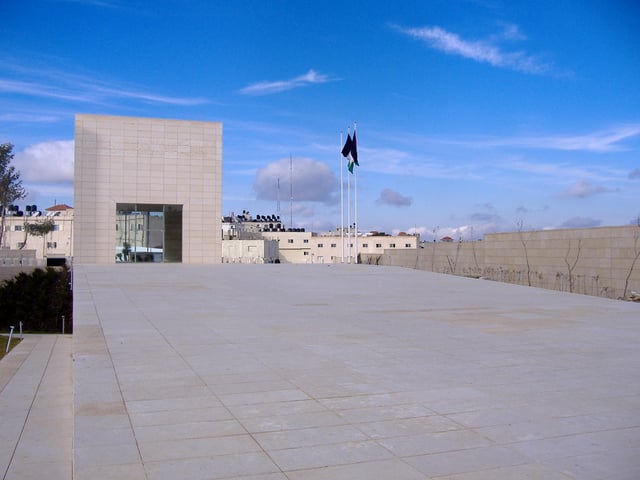
Arafat Mausoleum
Ramallah is generally considered the most affluent and cultural, as well as the most liberal, of all Palestinian cities,[76][77] and is home to a number of popular Palestinian activists, poets, artists, and musicians. It boasts a lively nightlife, with many restaurants including the Stars and Bucks Cafe, a branch of the Tche Tche Cafe and the Orjuwan Lounge, described in 2010 as two among the "dozens of fancy restaurants, bars and discotheques that have cropped up in Ramallah in the last three years".[52]
One hallmark of Ramallah is Rukab's Ice Cream, which is based on the resin of chewing gum and thus has a distinctive taste. Another is the First Ramallah Group, a boy- and girl-scout club that also holds a number of traditional dance (Dabka) performances and is also home to men's and women's basketball teams that compete regionally. International music and dance troupes occasionally make a stop in Ramallah, and the renowned Argentinian-Israeli pianist Daniel Barenboim performs there often. The Khalil Sakakini Cultural Center, founded in 1996, is a popular venue for such events. The Al-Kasaba Theatre is a venue for plays and movies. In 2004, the state-of-the art Ramallah Cultural Palace opened in the city. The only cultural center of its kind in the Palestinian-governed areas, it houses a 736-seat auditorium, as well as conference rooms, exhibit halls, and movie-screening rooms. It was a joint venture of the Palestinian Authority, the United Nations Development Programme (UNDP), and the Japanese government.[78] Ramallah hosted its first annual international film festival in 2004.
Ramallah folklore
Ramallah, like most Palestinian areas, has a rich folklore of song and dance. Songs accompanied people in every occasion whether it was the harvest season, roofing a house, traveling, coming back from travel, engagement, wedding, or even death. Most of the songs were sung by the women with the exception of Zaffeh and Mal'ab which are sung by the men at wedding celebrations. Palestinian educator Bahia Khalil's book "Ramallah Folklore Songs and Traditions" documents to a great extent this oral tradition inherited from one generation to another. The second edition of the book was published in 2002 by the American Federation of Ramallah, Palestine, an organization for Palestinian-Americans from the Ramallah region living in the United States.
Foreign travelers to Palestine in late 19th and early 20th centuries often commented on the rich variety of costumes among the Palestinian people, and particularly among the fellaheen or village women. Until the 1940s, a woman's economic status, whether married or single, and the town or area they were from could be deciphered by most Palestinian women by the type of cloth, colors, cut, and embroidery motifs, or lack thereof, used for the robe-like dress or "thoub" in Arabic
Palestinian costume
Though experts in the field trace the origins of Palestinian costumes to ancient times, there are no surviving clothing artifacts from this early period against which the modern items might be definitively compared. Influences from the various empires to have ruled Palestine, such as Ancient Egypt, Ancient Rome, Byzantine empire, and Ayyubids, among others, have been documented by scholars largely based on the depictions in art and descriptions in literature of costumes produced during these times.
Hanan Munayyer, collector and researcher of Palestinian clothing, sees examples of proto-Palestinian attire in artifacts from the Canaanite period (1500 BCE) such as Egyptian paintings depicting Canaanites in A-shaped garments.[79] Munayyer says that from 1200 BC to 1940 AD, all Palestinian dresses were cut from natural fabrics in a similar A-line shape with triangular sleeves.[79] This shape is known to archaeologists as the "Syrian tunic" and appears in artifacts such as an ivory engraving from Megiddo dating to 1200 BC.[79][80]
Until the 1940s, traditional Palestinian costumes reflected a woman's economic and marital status and her town or district of origin, with knowledgeable observers discerning this information from the fabric, colours, cut, and embroidery motifs (or lack thereof) used in the apparel.[81]
Due to the difficulty of travel in the 19th century, villages in Palestine remained isolated. As a result, clothing and accessories became a statement of region. In Ramallah, the back panels of dresses often incorporated a palm tree motif embroidered in cross-stitch.[82] Ramallah women were famous for their distinctive dress of white linen fabric embroidered with red silk thread. The headdress or smadeh worn in Ramallah was common throughout northern Palestine: a small roundish cap, padded and stiffened, with gold and silver coins set in a fringe with a long veil pinned to the back, sometimes of silk and sometimes embroidered.
Twin towns—sister cities
Ramallah is twinned with:
Notable residents
Paul Ajlouny
Mahmoud Eid
Amber Fares
Jibril Rajoub[90]
Mosab Hassan Yousef, former resident
See also
Al-Najah Secondary School
Palestinian Christians
Economy of the Palestinian territories

